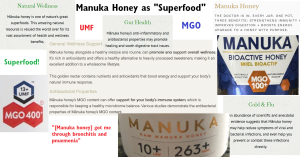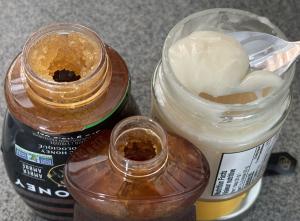
Evidence That Eating Manuka Honey Confers More Health Benefits Than Eating Any Raw Honey is Lacking
Methylglyoxal (MGO) made manuka honey famous for use in sterilized, medical grade wound dressings. There's no evidence of health benefits from ingesting MGO.
Manuka honey is produced when honeybees forage nectar from the manuka tree. (Leptospermum scoparium) a flowering tree native to New Zealand and Australia. Manuka honey is dark in color and strong in flavor. While opinions on manuka honey’s unique flavor range from exquisite to disgusting, most agree that manuka honey is less sweet than most honeys but exhibits a complex array of flavors. Most likely aren't eating manuka for the flavor.
In the 1980s Professor Peter Molan discovered that honey from the manuka tree contained an antibacterial compound that was different from the compounds that confer antibacterial activity to most other honeys. In 2007 this compound was identified as methylglyoxal, or MGO. Any raw honey has enzymes that catalyze the production of hydrogen peroxide (H2O2), which is a main contributor to the potent anti-bacterial properties of any natural raw honey. Unlike H2O2 and the enzymes that produce it which break down when heated, MGO remains intact at high temperatures. Most raw honeys’ antibacterial properties diminish when heated beyond 40°C (104°F), but manuka honey’s don’t. The realization that manuka honey could be used to make heat-sterilized medical grade wound dressings with potent antibacterial properties that are effective even against highly drug resistant bacteria, or “superbugs”, that can cause life-threatening wound infections dramatically increased demand for manuka honey.
What do sterilized wound dressings have to do with healthy eating?
Aside from marketing publicity, not much. As BBC's "Ask Me, I'm a Doctor" said "There is not enough evidence that methylglyoxal survives being eaten, nor that it does any good inside the body" A quick glance at the manuka honey in the food section of the store will reveal that price is closely related to its MGO or UMF numbers. MGO is a measure of the concentration of methylglyoxal. A marketing term “Unique Manuka Factor” (UMF) was created which is essentially another way of expressing the concentration of MGO.
The antibacterial properties of manuka or any raw honey are not what make honey a health food. They make honey a remarkably safe food to eat in its natural raw state, even when stored at ambient temperatures for months to years. The antibacterial and anti-fungal properties of raw honey are what prevents honey from spoiling in a way that could be harmful if eaten.
Eating any natural raw honey confers health benefits. The benefits of eating raw honey backed by modern scientific evidence include: reducing the risk of developing metabolic syndrome (a strong risk factor for heart disease), reducing risk of hypertension (high blood pressure), reducing the risk of developing (and possibly as a treatment for) diabetes, reducing cough and soothing sore throats, protecting against peptic ulcer disease, accelerating healing of peptic ulcers, decreasing the risk of obesity while promoting weight loss, improving sleep quality, and reducing inflammation. Raw honey may even reduce the risk of some cancers (Preliminary research).
Compare these health benefits to the health food benefits claimed by manuka honey (ignoring topical/wound dressing applications for this article) and you will find them remarkably similar: The benefits of eating manuka honey are simply the health benefits of consuming any raw honey. Some studies directly comparing honeys from different floral sources do find differences in the degree of specific individual benefits, with some honeys having slightly higher antioxidant properties, while other have slightly higher anti-inflammatory properties for example. Overall, each of the health benefits listed above can be obtained by eating any natural raw honey.
It is important to note that the health benefits listed above are for raw honey. Heating any honey (including manuka) to pasteurize or sterilize it breaks down some of the natural enzymes, polyphenols and flavonoids that confer these health benefits. Eating any raw honey is better for you than eating pasteurized or sterilized manuka honey. None of these health benefits are related to MGO concentration or UMF number.
While there may be some differences between different raw honeys and degree of a specific health benefit, these differences pale in comparison to the difference between eating pasteurized processed honey and eating raw honey. Even more important is the shocking amount of adulterated honey on store shelves. To increase profit, unscrupulous honey packagers, and even some honey producers, may adulterate natural honey with much cheaper syrups of processed sugars. This fraudulent activity replaces the health benefits of raw honey with the harms of eating excess processed sugars. From Food Safety News’ 2011 report that “Tests Show Most Store Honey Isn’t Honey” to the 2023 EU investigation into honey fraud which the Guardian headlined “All UK honey tested in EU fraud investigation fails authenticity test”, honey fraud appears to be rampant and ongoing.
Fetching a higher price with more profit to be made by adulteration, manuka honey has been a prime target for honey fraud. In 2014, The Independent reported that “According to New Zealand's leading manuka association, 1,800 tonnes a year of the honey are now consumed in the UK each year, out of an estimated 10,000 tonnes globally. Yet production of the genuine stuff is set at just 1,700 tonnes”, indicating that more than 5 times as much manuka is sold than is produced. Two separate investigations in the USA found that only 2 out of 5 jars of manuka honey on store shelves were authentic. If you’re willing to pay the high price, eating genuine, raw manuka honey will give you the health benefits of eating raw honey. The same cannot be said for fake manuka honey.
Jeremy Wendell
Wendell Estate Honey
+1 204-564-2599
email us here
Visit us on social media:
Facebook
Instagram
YouTube
Good Morning America Discusses Manuka Honey
EIN Presswire does not exercise editorial control over third-party content provided, uploaded, published, or distributed by users of EIN Presswire. We are a distributor, not a publisher, of 3rd party content. Such content may contain the views, opinions, statements, offers, and other material of the respective users, suppliers, participants, or authors.




